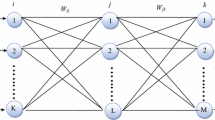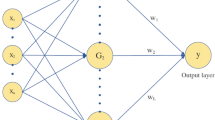Abstract
This paper investigates the ability of four artificial intelligence techniques, including artificial neural network (ANN), radial basis neural network (RBNN), adaptive neuro-fuzzy inference system (ANFIS) with grid partitioning, and ANFIS with fuzzy c-means clustering, to predict the peak and residual conditions of actively confined concrete. A large experimental test database that consists of 377 axial compression test results of actively confined concrete specimens was assembled from the published literature, and it was used to train, test, and validate the four models proposed in this paper using the mentioned artificial intelligence techniques. The results show that all of the neural network and ANFIS models fit well with the experimental results, and they outperform the conventional models. Among the artificial intelligence models investigated, RBNN model is found to be the most accurate to predict the peak and residual conditions of actively confined concrete. The predictions of each proposed model are subsequently used to study the interdependence of critical parameters and their influence on the behavior of actively confined concrete.














Similar content being viewed by others
References
Richart FE, Brandtzaeg A, Brown RL (1929) The failure of plain and spirally reinforced concrete in compression. Bulletin no. 190. Engineering experiment station. University of Illinois, Urbana
Saatcioglu M, Razvi SR (1992) Strength and ductility of confined concrete. J Struct Eng ASCE 118:1590–1607
Ozbakkaloglu T, Saatcioglu M (2006) Seismic behavior of high-strength concrete columns confined by fiber-reinforced polymer tubes. J Compos Constr ASCE 10:538–549
Ozbakkaloglu T, Lim JC, Vincent T (2013) FRP-confined concrete in circular sections: review and assessment of stress–strain models. Eng Struct 49:1068–1088
Richart FE, Brandtzaeg A, Brown RL (1928) A study of the failure of concrete under combined compressive stresses. Bulletin no. 185. Engineering experimental station. University of Illinois, Champaign
Mills LL, Zimmerman RM (1970) Compressive strength of plain concrete under multiaxial loading conditions. ACI J Proc 67:802–807
Mander JB, Priestley MJN, Park R (1988) Theoretical stress–strain model for confined concrete. J Struct Eng ASCE 114:1804–1826
Xie J, Elwi AE, Macgregor JG (1995) Mechanical-properties of high-strength concretes containing silica fume. ACI Mater J 92:135–145
Attard MM, Setunge S (1996) Stress–strain relationship of confined and unconfined concrete. ACI Mater J 93:432–442
Ansari F, Li QB (1998) High-strength concrete subjected to triaxial compression. ACI Mater J 95:747–755
Candappa DC, Sanjayan JG, Setunge S (2001) Complete triaxial stress–strain curves of high-strength concrete. J Mater Civ Eng 13:209–215
Imran I, Pantazopoulou SJ (2001) Plasticity model for concrete under triaxial compression. J Eng Mech ASCE 127:281–290
Binici B (2005) An analytical model for stress–strain behavior of confined concrete. Eng Struct 27:1040–1051
Jiang T, Teng JG (2007) Analysis-oriented stress–strain models for FRP-confined concrete. Eng Struct 29:2968–2986
Teng JG, Huang YL, Lam L, Ye LP (2007) Theoretical model for fiber-reinforced polymer-confined concrete. J Compos Constr ASCE 11:201–210
Xiao QG, Teng JG, Yu T (2010) Behavior and modeling of confined high-strength concrete. J Compos Constr ASCE 14:249–259
Samani AK, Attard MM (2012) A stress–strain model for uniaxial and confined concrete under compression. Eng Struct 41:335–349
Lim JC, Ozbakkaloglu T (2014) Stress–strain model for normal- and light-weight concretes under uniaxial and triaxial compression. Constr Build Mater 71:492–509
Sonebi M, Cevik A (2009) Genetic programming based formulation for fresh and hardened properties of self-compacting concrete containing pulverised fuel ash. Constr Build Mater 23:2614–2622
Cevik A (2011) Modeling strength enhancement of FRP confined concrete cylinders using soft computing. Expert Syst Appl 38:5662–5673
Jalal M, Ramezanianpour AA, Pouladkhan AR, Tedro P (2013) Application of genetic programming (GP) and ANFIS for strength enhancement modeling of CFRP-retrofitted concrete cylinders. Neural Comput Appl 23:455–470
Mashrei MA, Seracino R, Rahman MS (2013) Application of artificial neural networks to predict the bond strength of FRP-to-concrete joints. Constr Build Mater 40:812–821
Sadrmomtazi A, Sobhani J, Mirgozar MA (2013) Modeling compressive strength of EPS lightweight concrete using regression, neural network and ANFIS. Constr Build Mater 42:205–216
Pham TM, Hadi MN (2014) Predicting stress and strain of frp-confined square/rectangular columns using artificial neural networks. J Compos Constr 18(6):04014019
Altun F, Kisi O, Aydin K (2008) Predicting the compressive strength of steel fiber added lightweight concrete using neural network. Comput Mater Sci 42:259–265
Özcan F, Atiş CD, Karahan O, Uncuoğlu E, Tanyildizi H (2009) Comparison of artificial neural network and fuzzy logic models for prediction of long-term compressive strength of silica fume concrete. Adv Eng Softw 40:856–863
Sobhani J, Najimi M, Pourkhorshidi AR, Parhizkar T (2010) Prediction of the compressive strength of no-slump concrete: a comparative study of regression, neural network and ANFIS models. Constr Build Mater 24:709–718
Lim JC, Karakus M, Ozbakkaloglu T (2016) Evaluation of ultimate conditions of FRP-confined concrete columns using genetic programming. Comput Struct 162:28–37
Perera R, Barchín M, Arteaga A, Diego A (2010) Prediction of the ultimate strength of reinforced concrete beams FRP-strengthened in shear using neural networks. Compos B Eng. doi:10.1016/j.compositesb.2010.03.003
Perera R, Ruiz A (2012) Design equations for reinforced concrete members strengthened in shear with external FRP reinforcement formulated in an evolutionary multi-objective framework. Compos B Eng 43(2):488–496
Perera R, Tarazona D, Ruiz A, Martín A (2014) Application of artificial intelligence techniques to predict the performance of RC beams shear strengthened with NSM FRP rods. Formulation of design equations. Compos B Eng 66:162–173
Kisi O (2005) Suspended sediment estimation using neuro-fuzzy and neural network approaches. Hydrol Sci J 50:683–696
Haykin SS (2009) Neural networks and learning machines, 3rd edn. Prentice Hall, Upper Saddle River
Broomhead DS, Lowe D (1988) Multivariable functional interpolation and adaptive networks. Complex Syst 2:321–355
Poggio T, Girosi F (1990) Regularization algorithms for learning that are equivalent to multilayer networks. Science 2247:978–982
Specht DF (1991) A general regression neural network. IEEE Trans Neural Netw 2:569–576
Jang JSR (1993) ANFIS: adaptive-network-based fuzzy inference system. IEEE Trans Syst Man Cybern 23:665–685
Jang JSR, Sun CT (1997) Neuro-fuzzy and soft computing: a computational approach to learning and machine intelligence. Prentice Hall, Upper Saddle River
Mamdani EH (1974) Application of fuzzy algorithms for control of simple dynamic plant. Proc Inst Electr Electron Eng 121:1585–1588
Takagi T, Sugeno M (1985) Fuzzy identification of systems and its application to modeling and control. IEEE Trans Syst Man Cybern 15:116–132
Chen D, Gao C (2012) Soft computing methods applied to train station parking in urban rail transit. Appl Soft Comput 12:759–767
Ayvaza MT, Karahana H, Aral MM (2007) Aquifer parameter and zone structure estimation using kernel-based fuzzy c-means clustering and genetic algorithm. J Hydrol 343:240–253
Lim JC, Ozbakkaloglu T (2014) Lateral strain-to-axial strain relationship of confined concrete. J Struct Eng ASCE 141(5):04014141
Lim JC, Ozbakkaloglu T (2015) Investigation of the influence of application path of confining pressure: tests on actively confined and FRP-confined concretes. J Struct Eng ASCE 141(8):04014203
Tamuzs V, Tepfers R, You CS, Rousakis T, Repelis I, Skruls V, Vilks U (2006) Behavior of concrete cylinders confined by carbon-composite tapes and prestressed yarns, 1. Experimental data. Mech Compos Mater 42(1):13–32
Cinina I, Zile E, Zile O (2012) Mechanical behavior of concrete columns confined by basalt FRP windings. Mech Compos Mater 48(5):783–792
Janke L, Czaderski C, Ruth J, Motavalli M (2009) Experiments on the residual load-bearing capacity of prestressed confined concrete columns. Eng Struct 31(10):2247–2256
Rousakis TC, Tourtouras IS (2014) RC columns of square section—passive and active confinement with composite ropes. Compos B Eng 58:573–581
Vincent T, Ozbakkaloglu T (2015) Compressive behavior of prestressed high-strength concrete-filled aramid frp tube columns: experimental observations. J Compos Constr. doi:10.1061/(ASCE)CC.1943-5614.0000556,04015003
Rousakis TC, Tourtouras IS (2015) Modeling of passive and active external confinement of RC columns with elastic material. J Appl Math Mech 95(10):1046–1057
Lim JC, Ozbakkaloglu T (2014) Unified stress–strain model for FRP and actively confined normal-strength and high-strength concrete. J Compos Constr. doi:10.1061/(ASCE)CC.1943-5614.0000536,04014072
May RJ, Maier HR, Dandy GC (2010) Data splitting for artificial neural networks using SOM-based stratified sampling. Neural Netw 23:283–294
Cigizoglu HK (2003) Estimation, forecasting and extrapolation of river flows by artificial neural networks. Hydrol Sci J 48:349–361
Ay M, Kisi O (2014) Modelling of chemical oxygen demand by using ANNs, ANFIS and k-means clustering technique. J Hydrol 511:279–289
Compliance with ethical standards
Conflict of interest
The authors declare that they have no conflict of interest.
Author information
Authors and Affiliations
Corresponding author
Rights and permissions
About this article
Cite this article
Mansouri, I., Gholampour, A., Kisi, O. et al. Evaluation of peak and residual conditions of actively confined concrete using neuro-fuzzy and neural computing techniques. Neural Comput & Applic 29, 873–888 (2018). https://doi.org/10.1007/s00521-016-2492-4
Received:
Accepted:
Published:
Issue Date:
DOI: https://doi.org/10.1007/s00521-016-2492-4




